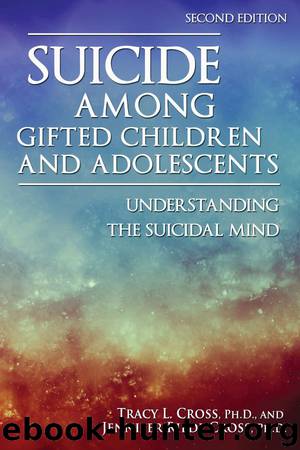Suicide Among Gifted Children and Adolescents by Tracy Cross

Author:Tracy Cross
Language: eng
Format: epub
Publisher: Sourcebooks
Figure 3. Illustration of suicide theories and students with gifts and talents leading to spiral model.
The bottom fourth of the triangle includes the four categories of the suicide trajectory model (see Table 11, p. 34, for a reminder of what those categories entail). The correlates and risk factors of suicidal behavior establish the foundation of the suicidal mind. However, many people function well, even with many of the suicidal correlates.
The STM establishes an excellent foundation of risk factors from which to look for and predict suicidal behavior. The four categories are comprehensive, including biological traits/characteristics (e.g., being male), psychological characteristics (e.g., mood states), negative cognitive patterns (e.g., self-talk), and environmental factors (e.g., social isolation and exposure to lethal weapons). These factors are at a level that educators could be trained to identify as a means to reduce the likelihood of suicidal behavior.
The next level of the triangle includes factors identified from research on the suicidal behavior of students with gifts and talents. Isolation, feeling different, lived experience, mixed messages, and others are layered on top of the factors of the STM.
The third tier of the triangle includes the elements within Shneidman’s (1993) theory. He described suicide as having four elements: (a) heightened inimicality, (b) exacerbation of perturbation, (c) increased constriction of intellectual focus, and (d) cessation. From the STM, we can now see how the process of the suicidal mind is becoming actively involved. As suicidal ideators increase their harmful thoughts and become more and more upset, they become less able to think about anything else. The only discernable solution is cessation: death. Factors associated with suicide can be considered kinetic, and Shneidman’s theory illustrated how the factors become activated or engaged.
As the person becomes increasingly involved in suicidal ideation, the factors noted in the STM, such as rigidity of thought, exacerbate the perturbation (increase the upset) that Shneidman (1993) described. This is where the two most important states can have the effect of preparing the person to die: psychache and hopelessness. As a person experiences increasing amounts of psychological and emotional pain, the variable of hopelessness becomes more and more important.
Risk factors can be considered distally related to suicide, while warning signs such as psychache and hopelessness are thought to be proximally associated with a suicidal behavior and related to imminent risk. Distal causes are believed to be the initial causative factors in the original environment, while proximal causes are current causative factors.
These proximal causes can be seen at the top of the triangle, in Shneidman’s (1993) psychache and the construct of hopelessness. The two states of mind are much closer to potential suicidal behavior than any of the correlates. However, the correlates provide fuel for the psychache that leads to hopelessness, which in turn leads to suicidal behavior.
SPIRAL MODEL OF THE SUICIDAL MIND OF GIFTED CHILDREN AND ADOLESCENTS
Building on the theories and research represented in the triangle in Figure 3, Tracy developed the spiral model of the suicidal mind of gifted children and adolescents, shown in Figure 4.
Download
This site does not store any files on its server. We only index and link to content provided by other sites. Please contact the content providers to delete copyright contents if any and email us, we'll remove relevant links or contents immediately.
They Both Die at the End by Adam Silvera(9679)
Thirteen Reasons Why by Jay Asher(8744)
The Space Between by Michelle L. Teichman(6818)
Suicide Notes by Michael Thomas Ford(4703)
Tuesdays with Morrie by Mitch Albom(4607)
Suicide: A Study in Sociology by Emile Durkheim(2950)
The Checklist Manifesto by Atul Gawande(2746)
Tuesdays With Morrie by Mitch Albom(2636)
In the Woods by Tana French(2502)
Bossypants by Tina Fey(2429)
Robin by Dave Itzkoff(2301)
Olive Kitteridge by Elizabeth Strout(2275)
No Ashes in the Fire by Darnell L Moore(2253)
Reservoir 13 by Jon McGregor(2219)
End of Days by Sylvia Browne(2088)
Bus on Jaffa Road by Mike Kelly(2083)
All Things New by John Eldredge(2083)
Scar Tissue by Anthony Kiedis(2042)
No Time to Say Goodbye(2029)
